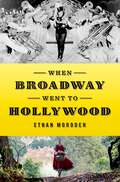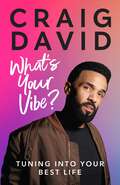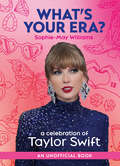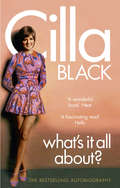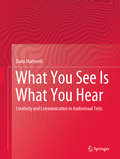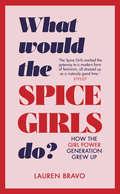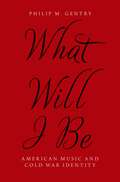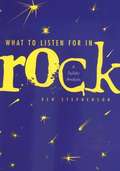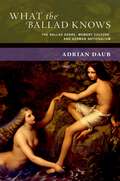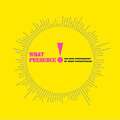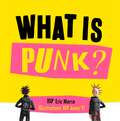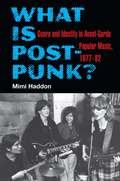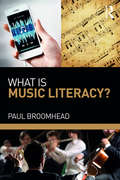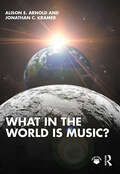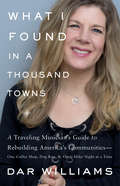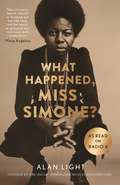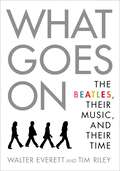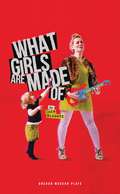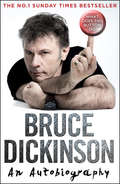- Table View
- List View
When Broadway Went to Hollywood
by Ethan MorddenWhen films like The Jazz Singer started to integrate synchronized music, in the late 1920s many ambitious songwriting pioneers of the Great White Way - George and Ira Gershwin, Cole Porter, Richard Rodgers, and Lorenz Hart, among many others - were enticed westward by Hollywood studios' promises of national exposure and top dollar success. But what happened when writers native to the business of Broadway ran into the very different business of Hollywood? Their movies had their producer despots, their stacking of writing teams on a single project, their use of five or six songs per story where Broadway fit in a dozen, and it seemed as if everyone in Hollywood was uncomfortable with characters bursting into song on the street, in your living room, or in "a cottage small by a waterfall." Did the movies give theater writers a chance to expand their art, or did mass marketing ruin the musical's quintessential charm? Is it possible to trace the history of the musical through both stage and screen manifestations, or did Broadway and Hollywood give rise to two wholly irreconcilable art forms? And, finally, did any New York writer or writing team create a film musical as enthralling and timeless as their work for the stage? In When Broadway Went to Hollywood, writer and celebrated steward of musical theatre Ethan Mordden directs his unmistakable wit and whimsy to these challenging questions and more, charting the volatile and galvanizing influence of Broadway on Hollywood (and vice versa) throughout the twentieth century. Along the way, he takes us behind the scenes of the great Hollywood musicals you've seen and loved (The Wizard of Oz, Gigi, The Sound of Music, Chicago, West Side Story, The Music Man, Grease) as well as some of the outrageous flops you probably haven't. The first book to tell the story of how Broadway affected the Hollywood musical, When Broadway Goes to Hollywood is sure to thrill theatre buffs and movie lovers alike.
When Broadway Went to Hollywood
by Ethan MorddenWhen films like The Jazz Singer started to integrate synchronized music, in the late 1920s many ambitious songwriting pioneers of the Great White Way - George and Ira Gershwin, Cole Porter, Richard Rodgers, and Lorenz Hart, among many others - were enticed westward by Hollywood studios' promises of national exposure and top dollar success. But what happened when writers native to the business of Broadway ran into the very different business of Hollywood? Their movies had their producer despots, their stacking of writing teams on a single project, their use of five or six songs per story where Broadway fit in a dozen, and it seemed as if everyone in Hollywood was uncomfortable with characters bursting into song on the street, in your living room, or in "a cottage small by a waterfall." Did the movies give theater writers a chance to expand their art, or did mass marketing ruin the musical's quintessential charm? Is it possible to trace the history of the musical through both stage and screen manifestations, or did Broadway and Hollywood give rise to two wholly irreconcilable art forms? And, finally, did any New York writer or writing team create a film musical as enthralling and timeless as their work for the stage? In When Broadway Went to Hollywood, writer and celebrated steward of musical theatre Ethan Mordden directs his unmistakable wit and whimsy to these challenging questions and more, charting the volatile and galvanizing influence of Broadway on Hollywood (and vice versa) throughout the twentieth century. Along the way, he takes us behind the scenes of the great Hollywood musicals you've seen and loved (The Wizard of Oz, Gigi, The Sound of Music, Chicago, West Side Story, The Music Man, Grease) as well as some of the outrageous flops you probably haven't. The first book to tell the story of how Broadway affected the Hollywood musical, When Broadway Goes to Hollywood is sure to thrill theatre buffs and movie lovers alike.
What’s Your Vibe?: Tuning into your best life
by Craig David***I'm still learning, still making mistakes, but I feel ready now - after a lot of twists and turns along the way - to share my journey with you. In his much-anticipated first book, celebrated singer-songwriter Craig David takes us on a journey of connecting, disconnecting and reconnecting, weaving together stories of his life and music - starting with his early days in Southampton working with The Artful Dodger, to his overnight chart-topping success, through to the present day, and everything in between.This is Craig as we've never seen him before - the always-positive showman, baring his soul for the first time.From physical pain, lost love, public humiliation and depression, Craig takes us past his comfort zone, in a raw, honest and courageous account of his own lived experience. In opening up about how he overcame these obstacles, Craig shares his insight and provides practical advice that will help us to navigate the daily challenges we all face.This is Craig's story of how he learned to tune into his best life.
What’s Your Era?: A celebration of Taylor Swift
by null Sophie-May WilliamsAre you a Fearless enthusiast or a Reputation-era renegade? Discover which Taylor Swift era you truly belong to with the ultimate guide for any Swiftie. Taylor has enchanted the world with her music and unapologetically authentic persona. This book explores the exciting tapestry of her career, from her country beginnings to her chart-topping pop anthems. A love letter to the woman who created the soundtrack to so many of our lives, What's Your Era? is a deep dive into each album and what they mean in the wider scope of her career. If you're looking to incorporate more of Taylor's energy and style into your life, or simply want to brush up on your Taylor Swift knowledge, this book is your essential companion. With outfit inspiration for each era, quizzes, and Taylor-themed activities, you'll be all set, whether you're hosting the ultimate Taylor Swift party or prepping for one of her concerts.
What's It All About?: On-line Retail
by Cilla BlackCilla Black is without doubt one of Britain's most treasured personalities. Generations have grown up with Cilla's music, TV shows, and performances. But how much do we really know about 'the girl with the bright red hair and the jet black voice'? What's It All About? is Cilla's own story, told for the first time ever. It's the story of a woman who has worked ceaselessly to stay at the top for forty years despite setbacks and personal tragedy; a life of incredible highs and terrible lows. In this deeply personal autobiography she tells her unique story in intimate and vivid detail for the very first time. This is the real Cilla Black.
What You See Is What You Hear: Creativity and Communication in Audiovisual Texts
by Dario MartinelliWhat You See Is What You Hear develops a unique model of analysis that helps students and advanced scholars alike to look at audiovisual texts from a fresh perspective. Adopting an engaging writing style, the author draws an accessible picture of the field, offering several analytical tools, historical background, and numerous case studies. Divided into five main sections, the monograph covers problems of definitions, history, and most of all analysis. The first part raises the main problems related to audiovisuality, including taxonomical and historical questions. The second part provides the bases for the understanding of audiovisual creative communication as a whole, introducing a novel theoretical model for its analysis. The next three part focus elaborate on the model in all its constituents and with plenty of case studies taken from the field of cinema, TV, music videos, advertising and other forms of audiovisuality. Methodologically, the book is informed by different paradigms of film and media studies, multimodality studies, structuralism, narratology, “auteur theory” in the broad sense, communication studies, semiotics, and the so-called “Numanities.” What You See Is What You Hear enables readers to better understand how to analyze the structure and content of diverse audiovisual texts, to discuss their different idioms, and to approach them with curiosity and critical spirit.
What Would the Spice Girls Do?: How the Girl Power Generation Grew Up
by Lauren Bravo'A joyous and energetic celebration of girlhood, friendship and pop culture. If you have ever sung into the lid of a can of Impulse body spray, you need to read this.' Daisy BuchananThe words 'girl power' conjure vivid memories of short skirts and platform boots. But it wasn't just about the look, it was about feminism. The Spice Girls gave a generation their first glimpse of the power of friendship, of staying true to yourself, of sheer bloody-mindedness. And the girl power generation went on to kick-start a new conversation around gender equality.We may have grown up asking What Would the Spice Girls Do?, but their particular brand of feminism is as relevant today as it was twenty years ago – we still need that fun and fearlessness, we still need accessible and all-embracing equality… we still need a zig-a-zig-ah.‘Lauren Bravo is one of my very favourite writers.’ Dolly Alderton‘The Spice Girls’ arrival on the pop scene marked the gateway to a modern form of feminism, all dressed up as a riotously good time.’ Stylist
What Will I Be: American Music and Cold War Identity
by Philip M. GentryIn the wake of World War II, the cultural life of the United States underwent a massive transformation. At the heart of these changes during the early Cold War were the rise of the concept of identity and a reformulation of the country's political life. A revolution in music was taking place at the same time-a tumult of new musical styles and institutions that would lead to everything from the birth of rock 'n' roll to the new downtown experimental music scene. Together, these new cultural and musical trends came to define the era. In the search for new social affinities and modes of self-fashioning, music provided just the right tool. What Shall I Be follows the concept of identity as it developed alongside new post-war music making. Author Philip M. Gentry travels through four very different musical scenes: the R&B world of doo-wop pioneers the Orioles, the early film musicals of Doris Day, Asian American cabaret in San Francisco, and John Cage's infamous 4'33". The lives of musicians, composers, critics, and fans reveal how individuals negotiated the social changes sweeping the country in the initial days of the Cold War. As we are again swept up in a time of significant transformation, these early strategies help to inform the political and musical narratives of today.
What Will I Be: American Music and Cold War Identity
by Philip M. GentryIn the wake of World War II, the cultural life of the United States underwent a massive transformation. At the heart of these changes during the early Cold War were the rise of the concept of identity and a reformulation of the country's political life. A revolution in music was taking place at the same time-a tumult of new musical styles and institutions that would lead to everything from the birth of rock 'n' roll to the new downtown experimental music scene. Together, these new cultural and musical trends came to define the era. In the search for new social affinities and modes of self-fashioning, music provided just the right tool. What Shall I Be follows the concept of identity as it developed alongside new post-war music making. Author Philip M. Gentry travels through four very different musical scenes: the R&B world of doo-wop pioneers the Orioles, the early film musicals of Doris Day, Asian American cabaret in San Francisco, and John Cage's infamous 4'33". The lives of musicians, composers, critics, and fans reveal how individuals negotiated the social changes sweeping the country in the initial days of the Cold War. As we are again swept up in a time of significant transformation, these early strategies help to inform the political and musical narratives of today.
What to Listen for in Rock: A Stylistic Analysis (PDF)
by Ken StephensonIn this concise and engaging analysis of rock music, music theorist Ken Stephenson explores the features that make this internationally popular music distinct from earlier music styles. The author offers a guided tour of rock music from the 1950s to the present, emphasizing the theoretical underpinnings of the style and, for the first time, systematically focusing not on rock music's history or sociology, but on the structural aspects of the music itself. What structures normally happen in rock music? What theoretical systems or models might best explain them? The book addresses these questions and more in chapters devoted to phrase rhythm, scales, key determination, cadences, harmonic palette and succession, and form. Each chapter provides richly detailed analyses of individual rock pieces from groups including Chicago; the Beatles; Emerson, Lake, and Palmer; Kansas; and others. Stephenson shows how rock music is stylistically unique, and he demonstrates how the features that make it distinct have tended to remain constant throughout the past half-century and within most substyles. For music students at the college level and for practicing rock musicians who desire a deeper understanding of their music, this book is an essential resource.
What the Ballad Knows: The Ballad Genre, Memory Culture, and German Nationalism (New Cultural History of Music)
by Adrian DaubOver the course of the 19th century, ballads proliferated in German-speaking Europe in a truly remarkable range of contexts. Audiences were of course likely encounter balladry in the volumes of Goethe and Schiller, in various anthologies or illustrated editions. But they were just as likely to come across objects billed as ballads in recitation evenings by popular actors, in song-settings by Schubert and Loewe, in piano pieces by Chopin, in the opera house and the concert hall, in mass-produced drawings, paintings and even chinaware. Ballads were poems one could use - schoolteachers used them to train their students' memory (or punish them), women composers used them to assert their place in the musical canon, actors used them to bolster their income, mothers used them to put their children to sleep. Ballads intersected with gender and class, promising to democratize art, while in fact helping make distinctions. In What the Ballad Knows: The Ballad Genre, Memory Culture and German Nationalism, Adrian Daub tells the story of this itinerant genre across media, periods, regions and social strata and shows that, even though it was often positioned as an authentic product of "German spirit," the ballad frequently unsettled and subverted the national project. The popular imagination rooted these poems in pre-modern oral culture, among bards and peasants in the everyday life of common folk. But in fact nineteenth-century ballads were in the end all about modernity modern modes of association, of attention, of dissemination.
What the Ballad Knows: The Ballad Genre, Memory Culture, and German Nationalism (New Cultural History of Music)
by Adrian DaubOver the course of the 19th century, ballads proliferated in German-speaking Europe in a truly remarkable range of contexts. Audiences were of course likely encounter balladry in the volumes of Goethe and Schiller, in various anthologies or illustrated editions. But they were just as likely to come across objects billed as ballads in recitation evenings by popular actors, in song-settings by Schubert and Loewe, in piano pieces by Chopin, in the opera house and the concert hall, in mass-produced drawings, paintings and even chinaware. Ballads were poems one could use - schoolteachers used them to train their students' memory (or punish them), women composers used them to assert their place in the musical canon, actors used them to bolster their income, mothers used them to put their children to sleep. Ballads intersected with gender and class, promising to democratize art, while in fact helping make distinctions. In What the Ballad Knows: The Ballad Genre, Memory Culture and German Nationalism, Adrian Daub tells the story of this itinerant genre across media, periods, regions and social strata and shows that, even though it was often positioned as an authentic product of "German spirit," the ballad frequently unsettled and subverted the national project. The popular imagination rooted these poems in pre-modern oral culture, among bards and peasants in the everyday life of common folk. But in fact nineteenth-century ballads were in the end all about modernity modern modes of association, of attention, of dissemination.
What Presence!: The Rock Photography of Harry Papadopoulos
by Kenneth McCluskeyHarry Papadopoulos began his photographic career outside the Apollo in Glasgow, flogging photographs to gig-goers. He soon moved to London, and from 1979 to 1984 worked as a staff photographer for Sounds, for which he provided countless front covers. During those five years he covered Blondie, David Bowie, Devo, Joy Division, Bryan Ferry, Siouxsie and the Banshees, The Clash, The Specials, Wham!, ABC, Edwyn Collins, The Associates and many, many more. Harry's London flat also became home to fellow Scots such as Aztec Camera, Orange Juice and the Bluebells. Savour Peter Capaldi, years before he mutated into Malcolm Tucker, looking cute and wholesome as frontman of Glasgow band The Dreamboys(with US chat show host Craig Ferguson on drums) and relive the inky-fingered days of the 1980s music press with this fascinating look at the work of guerrilla lensman Harry Papadopoulos.
What is Punk?
by Eric MorseOnce upon a time, there was a deafening roar, that awakened the people, like never before ...What Is Punk? is a must-read pop-culture primer – an introduction to the punk revolution, recreated in vivid 3D clay photographs and told through rhyming couplets.From London’s Sex Pistols and The Clash to the Ramones’ NYC protopunk, from Iggy Pop to X-Ray Spex, this volume depicts some of our culture’s seminal moments and iconic characters.A delightful read for adults and children alike, illustrated in a truly unique visual style, What Is Punk? lays the groundwork for the next generation of little punks.
What Is Post-Punk?: Genre and Identity in Avant-Garde Popular Music, 1977-82
by Mimi HaddonPopular music in the US and UK during the late 1970s and early 1980s was wildly eclectic and experimental. “Post-punk,” as it was retroactively labeled, could include electro-pop melodies, distorted guitars, avant-garde industrial sounds, and reggae beats, and thus is not an easily definable musical category. What Is Post-Punk? combines a close reading of the late-1970s music press discourse with musical analyses and theories of identity to unpack post-punk’s status as a genre. Mimi Haddon traces the discursive foundations of post-punk across publications such as Sounds, ZigZag, Melody Maker, the Village Voice, and the NME, and presents case studies of bands including Wire, PiL, Joy Division, the Raincoats, and Pere Ubu. By positioning post-punk in relation to genres such as punk, new wave, dub, and disco, Haddon explores the boundaries of post-punk, and reveals it as a community of tastes and predilections rather than a stylistically unified whole. Haddon diversifies the discourse around post-punk, exploring both its gender and racial dynamics and its proto-industrial aesthetics to restore the historical complexity surrounding the genre’s terms and origins.
What is Music Literacy?
by Paul BroomheadWhat is Music Literacy? attempts to redefine music literacy with a more expansive meaning than is commonly in use, and to articulate the potential impact of these ideas on music teaching practice. The notion of music literacy has involved the ability to read and write music scores. However, this understanding does not extend theory to identify all music texts, nor to offer a thorough treatment of what impact an expanded notion of music literacy might have on music instruction in the classroom and in ensembles. This book provides a formal, expansive redefinition of music literacy. The author offers practical ideas for attending more effectively to music literacy in classroom instruction. The book highlights common elements in the music classroom: the music score, the conductor, surrounding ensemble members, the musical model, the musical instrument, and presentations/recordings. It also describes four orientations that correspond to the National Core Music Standards (2014) and that characterize humans’ interactions with music: creator, performer, responder, and connector. What is Music Literacy? uses these orientations, along with a focus on authentic music texts and literacies, to present literacy-based guidelines for music education along with numerous vignettes that describe actual literacy instructional events.
What is Music Literacy?
by Paul BroomheadWhat is Music Literacy? attempts to redefine music literacy with a more expansive meaning than is commonly in use, and to articulate the potential impact of these ideas on music teaching practice. The notion of music literacy has involved the ability to read and write music scores. However, this understanding does not extend theory to identify all music texts, nor to offer a thorough treatment of what impact an expanded notion of music literacy might have on music instruction in the classroom and in ensembles. This book provides a formal, expansive redefinition of music literacy. The author offers practical ideas for attending more effectively to music literacy in classroom instruction. The book highlights common elements in the music classroom: the music score, the conductor, surrounding ensemble members, the musical model, the musical instrument, and presentations/recordings. It also describes four orientations that correspond to the National Core Music Standards (2014) and that characterize humans’ interactions with music: creator, performer, responder, and connector. What is Music Literacy? uses these orientations, along with a focus on authentic music texts and literacies, to present literacy-based guidelines for music education along with numerous vignettes that describe actual literacy instructional events.
What in the World is Music?
by Alison E. Arnold Jonathan C. KramerWhat in the World is Music? Second Edition is an undergraduate, interactive e-textbook that explores the shared ways people engage with music and how humans organize and experience sound. It adopts a global approach, featuring more than 300 streaming videos and 50 streaming audio tracks of music from around the world. Drawing from both musicological and ethnomusicological modes of inquiry, the authors explain the nature and meaning of music as a universal human practice, making no distinction between Western and non-Western repertoires while providing students with strong points of connection to the ways it affects their own lives. The What in the World is Music? curriculum is divided into five parts, with a fully integrated multimedia program linked directly to the chapters: The Foundations of Music I proposes a working definition of "music" and considers inquiry-guided approaches to its study: Why do humans have innate musical perception? How does this ability manifest itself in the human voice? A catalog of musical instruments showcases global diversity and human ingenuity. The Foundations of Music II continues the inquiry-guided approach, recognizing the principles by which musical sound is organized while discussing elements such as rhythm, melody, harmony, texture, form, genre, and style. Where did music come from? What is it for? Music and Identity examines how music operates in shaping, negotiating, and expressing human identity and is organized around three broad conceptual frames: the group, hybridity, and conflict. Music and the Sacred addresses how music is used in religious practices throughout the world: chanting sacred texts and singing devotional verses, inspiring religious experience such as ecstasy and trance, and marking and shaping ritual space and time. Music and Social Life analyzes the uses of music in storytelling, theater, and film. It delves into the contributions of sound technologies, while looking at the many ways music enhances nightlife, public ceremonies, and festivals.
What in the World is Music?
by Alison E. Arnold Jonathan C. KramerWhat in the World is Music? Second Edition is an undergraduate, interactive e-textbook that explores the shared ways people engage with music and how humans organize and experience sound. It adopts a global approach, featuring more than 300 streaming videos and 50 streaming audio tracks of music from around the world. Drawing from both musicological and ethnomusicological modes of inquiry, the authors explain the nature and meaning of music as a universal human practice, making no distinction between Western and non-Western repertoires while providing students with strong points of connection to the ways it affects their own lives. The What in the World is Music? curriculum is divided into five parts, with a fully integrated multimedia program linked directly to the chapters: The Foundations of Music I proposes a working definition of "music" and considers inquiry-guided approaches to its study: Why do humans have innate musical perception? How does this ability manifest itself in the human voice? A catalog of musical instruments showcases global diversity and human ingenuity. The Foundations of Music II continues the inquiry-guided approach, recognizing the principles by which musical sound is organized while discussing elements such as rhythm, melody, harmony, texture, form, genre, and style. Where did music come from? What is it for? Music and Identity examines how music operates in shaping, negotiating, and expressing human identity and is organized around three broad conceptual frames: the group, hybridity, and conflict. Music and the Sacred addresses how music is used in religious practices throughout the world: chanting sacred texts and singing devotional verses, inspiring religious experience such as ecstasy and trance, and marking and shaping ritual space and time. Music and Social Life analyzes the uses of music in storytelling, theater, and film. It delves into the contributions of sound technologies, while looking at the many ways music enhances nightlife, public ceremonies, and festivals.
What I Found in a Thousand Towns: A Traveling Musicians Guide to Rebuilding Americas Communities-One Coffee Shop, Dog Run, and Open-Mike Night at a Time
by Dar WilliamsA beloved folk singer presents an impassioned account of the fall and rise of the small American towns she cherishes. Dubbed by the New Yorker as "one of America's very best singer-songwriters," Dar Williams has made her career not in stadiums, but touring America's small towns. She has played their venues, composed in their coffee shops, and drunk in their bars. She has seen these communities struggle, but also seen them thrive in the face of postindustrial identity crises. Here, in an account that "reads as if Pete Seeger and Jane Jacobs teamed up" (New York Times), Williams muses on why some towns flourish while others fail, examining elements from the significance of history and nature to the uniting power of public spaces and food. Drawing on her own travels and the work of urban theorists, Williams offers real solutions to rebuild declining communities. What I Found in a Thousand Towns is more than a love letter to America's small towns, it's a deeply personal and hopeful message about the potential of America's lively and resilient communities.
What Happened, Miss Simone?: A Biography
by Alan Light'From her raging, handwritten letters to late-night phone calls with David Bowie, this biography gets up close and personal with the tempestuous Nina Simone' Observer Drawing on glimpses into previously unseen diaries, rare interviews and childhood journals, and with the aid of her daughter, What Happened, Miss Simone? tells the story of the classically trained pianist who became a soul legend, a committed civil rights activist and one of the most influential, provocative and least understood artists of our time. This is the story of the real Miss Simone.
WHAT GOES ON C: The Beatles, Their Music, and Their Time
by Tim Riley Walter EverettIn a stretch of just seven years, the Beatles recorded hundreds of songs which tower above those of their worthy peers as both the product of cultural leadership and an artistic reflection of their turbulent age, the1960s. Walter Everett and Tim Riley's What Goes On: The Beatles, Their Music, and Their Time blends historical narrative, musicology, and music analysis to tell the full story of the Beatles and how they redefined pop music. The book traces the Beatles' development chronologically, marking the band's involvement with world events such as the Vietnam War, strides in overcoming racial segregation, gender stereotyping, student demonstrations, and the generation gap. It delves deeply into their body of work, introducing the concepts of musical form, instrumentation, harmonic structure, melodic patterns, and rhythmic devices in a way that is accessible to musicians and non-musicians alike. Close readings of specific songs highlight the tensions between imagination and mechanics, songwriting and technology, and through the book's musical examples, listeners will learn how to develop strategies for creating their own rich interpretations of the potential meanings behind their favorite songs. Videos hosted on the book's companion website offer full definitions and performance demonstrations of all musical concepts discussed in the text, and interactive listening guides illustrate track details in real-time listening. The unique multimedia approach of What Goes On reveals just how great this music was in its own time, and why it remains important today as a body of singular achievement.
What Goes On: The Beatles, Their Music, and Their Time
by Walter Everett Tim RileyIn a stretch of just seven years, the Beatles recorded hundreds of songs which tower above those of their worthy peers as both the product of cultural leadership and an artistic reflection of their turbulent age, the1960s. Walter Everett and Tim Riley's What Goes On: The Beatles, Their Music, and Their Time blends historical narrative, musicology, and music analysis to tell the full story of the Beatles and how they redefined pop music. The book traces the Beatles' development chronologically, marking the band's involvement with world events such as the Vietnam War, strides in overcoming racial segregation, gender stereotyping, student demonstrations, and the generation gap. It delves deeply into their body of work, introducing the concepts of musical form, instrumentation, harmonic structure, melodic patterns, and rhythmic devices in a way that is accessible to musicians and non-musicians alike. Close readings of specific songs highlight the tensions between imagination and mechanics, songwriting and technology, and through the book's musical examples, listeners will learn how to develop strategies for creating their own rich interpretations of the potential meanings behind their favorite songs. Videos hosted on the book's companion website offer full definitions and performance demonstrations of all musical concepts discussed in the text, and interactive listening guides illustrate track details in real-time listening. The unique multimedia approach of What Goes On reveals just how great this music was in its own time, and why it remains important today as a body of singular achievement.
What Girls Are Made Of (Oberon Modern Plays)
by Cora BissettIt’s 1992. In a small town in Fife, a girl is busting to get out into the world and see what's on offer. And an ad in the local paper declares: BAND SEEKS SINGER.Grunge has just gone global, scruffy indie kids are inheriting the earth, and a schoolgirl from Glenrothes is catapulted to a rock star lifestyle as the singer in a hot new indie band. Touring with Radiohead, partying with Blur, she was living the dream. Until she wasn’t.Based on her meticulously detailed, pull-no-punches teenage diaries, this is the true story of Cora Bissett’s rollercoaster journey from the girl she was to the woman she wanted to be.
What Does This Button Do?: An Autobiography
by Bruce Dickinson‘I was spotty, wore an anorak, had biro-engraved flared blue jeans with “purple” and “Sabbath” written on the thighs, and rode an ear-splittingly uncool moped. Oh yes, and I wanted to be a drummer…’
